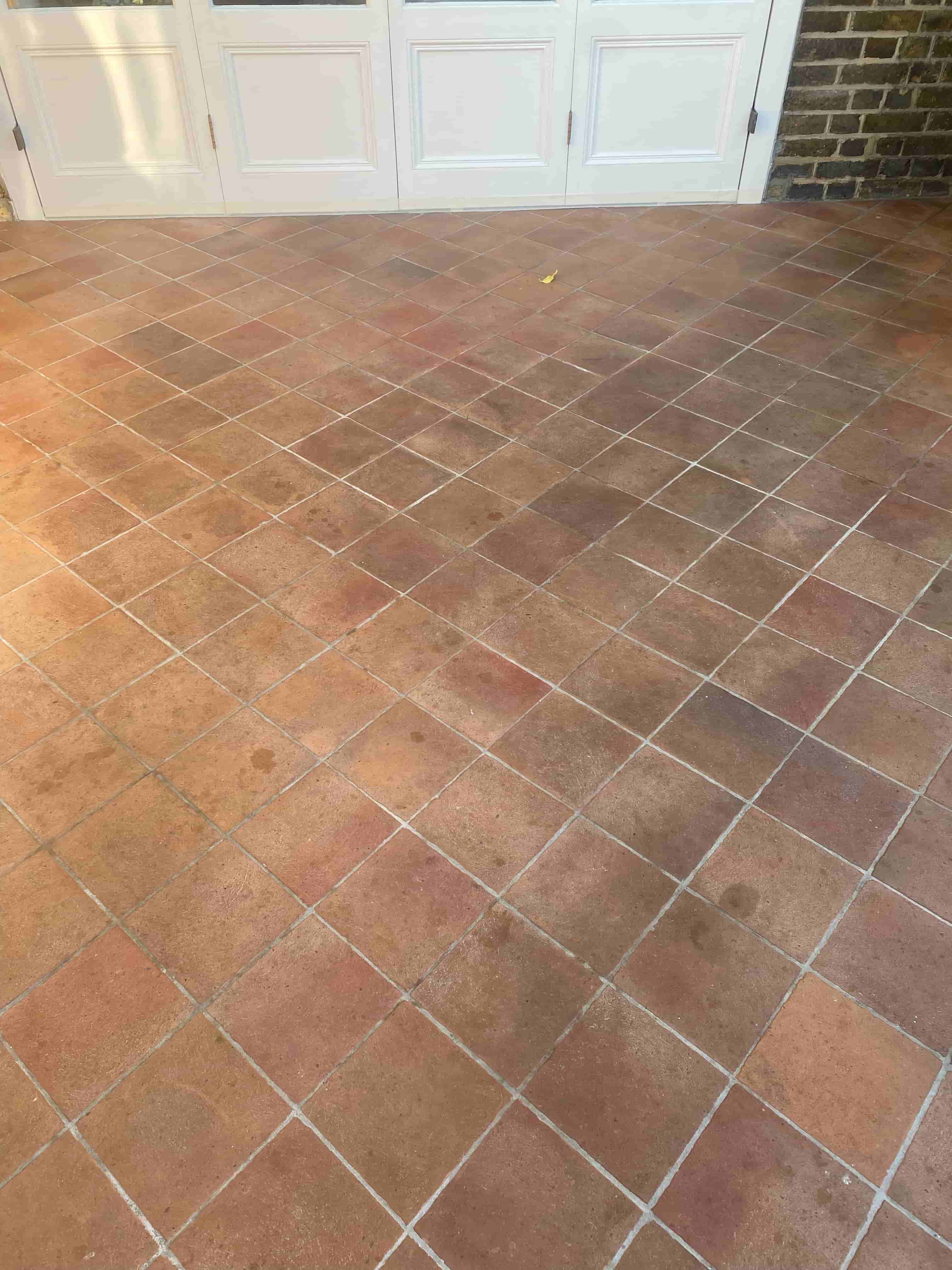The following photos are of a Terracotta floor I recently worked on in the conservatory of a property in the South London suburb of Herne Hill SE25. The room was going to receive a makeover and they were not sure whether to replace the floor or not. The terracotta tiles were very dirty and although they had tried cleaning it themselves, they struggled to get a result so decided to call in Tile Doctor.
I went over to survey the floor and could see that any sealer that was once on the tiles had completely worn away and without the protection of sealer dirt had become ingrained into the pores of the tile. Once that happens it can be troublesome to remove deep seated dirt from within Terracotta due the porosity of the clay-based tile.

However, having done quite a few of these floors previously I was confident with the right approach it could be deep cleaned and then a fresh sealer applied to protect it going forward. On the subject of sealers, they told me that they did not want a shiny finish so I quoted the job to clean and seal with an impregnating sealer that would meet their requirements.
I quoted for two days work, one day to clean and one day to seal and with the quote agreed the work was scheduled.
Deep Cleaning a Terracotta Conservatory Floor Tiles
On my return I started the cleaning process by applying a strong dilution of Tile Doctor Remove and Go combined 1 to 1 with Nanotech HBU Remover. Remove & Go is a multipurpose stripper with a long dwell time designed to remove old sealers and ingrained stains and the “Nanotech HBU Remover” is a heavy build-up cleaning product that uses nano sized particles to penetrate below the surface and draw out the ingrained dirt and stains.
Nanotech is a gel like substance and combined with the Remove & Go it makes for a powerful double action tile cleaning product. For maximum results It was left to sit on the floor for 30 minutes without allowing it to dry up or soak in. I then scrubbed the solution into the floor with a black scrubbing pad attached to a rotary floor machine. This action released the dirt from the tile and grout causing the cleaning solution to go black. The resulting slurry was then rinsed away with water extracted using a wet vacuum.

With the floor already looking significantly cleaner I moved onto the next step of giving the tiles and acid rinse using a 1:5 parts dilution of Tile Doctor Grout Clean-up. This product is a phosphoric acid based cleaner, which amongst other things removes efflorescence and lime deposits, being acidic it also neutralises the strong alkaline chemicals used to clean. I apply this solution by hand using stainless steel scouring pads for the tiles and a wire brush for the grout lines. I work in one metre square sections at a time, not allowing the solution to sit on the tiles for more than five minutes before vacuuming up the dirty solution.
One I had cleaned the whole floor with the “Grout Clean-Up” solution I then rinsed it with a steam cleaner. I use a steam cleaner for two reasons, for one it doesn’t soak the floor and the heat means it dries quicker and two any stains still there get drawn out by the steam.

Sealing Terracotta Conservatory Floor Tiles
It’s not good practice to apply a sealer to a damp floor as the dampness can cloud the sealer and result in a patchy appearance. Because of this I always seal on a second day and in this case, I left the floor to dry out fully for two days before returning.
To seal the floor, I used four coats of Tile Doctor Colour Grow which is an impregnating sealer that soaks into the pores of the Terracotta occupying the tiny pores and thereby blocking dirt from becoming ingrained there. Colour Grow as its name suggests improves the natural colours in the tile and in this case it did well to bring out the Orange/Red colours in the Terracotta, it also leaves a matt finish as requested by the client.

For aftercare I recommend Tile Doctor Neutral Cleaner, sealers are vulnerable to harsh chemicals so its important to use a cleaner that won’t impact them. It’s always worth checking the small print when buying a cleaner as the wrong product can degrade the sealer and then your back to square one with the floor becoming dirty with ingrained dirt.


When cleaning floor tiles with a mop we recommend using two buckets, one containing a neutral pH cleaning fluid such as Tile Doctor Neutral Tile Cleaner or Stone Soap and the second where you rinse your mop afterwards, otherwise you will contaminate your cleaning fluid with dirt every time you rinse.